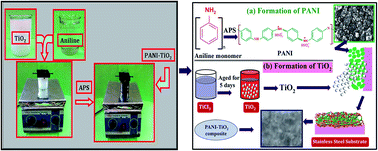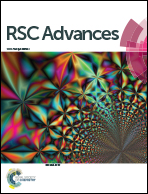Chemical synthesis of PANI–TiO2 composite thin film for supercapacitor application
Abstract
A unique and cost effective chemical route has been carried out for the synthesis of a polyaniline–titanium oxide (PANI–TiO2) composite thin film at room temperature. Characterization techniques, such as Fourier transform infrared and FT-Raman spectroscopy; have shown the formation of the composite. The result of X-ray diffraction indicates the amorphous nature of the PANI–TiO2 composite thin film. The morphology of the PANI–TiO2 composite thin film observed using scanning electron microscopy shows the porous framework of the agglomerated nanofibers. The electrochemical characterization of the pseudocapacitive PANI–TiO2 composite in a 1 M H2SO4 electrolyte displayed the highest specific capacitance of 783 F g−1 at the scan rate of 5 mV s−1. The synergistic effect between PANI with its counterpart TiO2 caused an increased cycle stability of 78% over 5000 consecutive cycles, which is higher than the virgin PANI with 70% specific capacitance retention. The distinctive structure of the PANI–TiO2 composite and the cohabitation of conducting PANI with TiO2 have been found to be responsible for the superior electrochemical properties.


 Please wait while we load your content...
Please wait while we load your content...